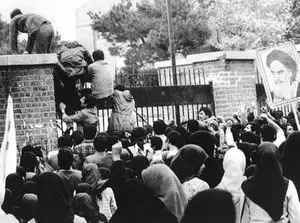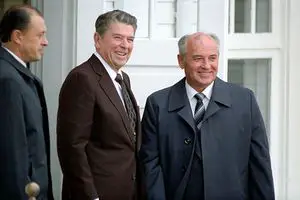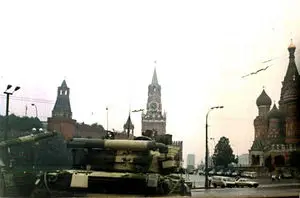Difference between revisions of "Why did the United States Gain the Upper Hand Against the Soviet Union at the End of the Cold War"
m (insert middle ad) |
|||
| Line 26: | Line 26: | ||
Perhaps the largest change in Soviet foreign policy was that of weakening total control over Eastern Europe. The Soviet bloc faced a series of crushing interventions against any semblance of independence, including in Hungary in 1956 and Czechoslovakia in 1968. Gorbachev announced in 1988 that he would cease this policy, which further increased calls for self-determination. Many in the Eastern European states soured on the slow economic growth and poor conditions under Soviet domination. As Gorbachev opened up the Soviet bloc's press and economy Eastern Europe would begin fading farther out of his grasp. | Perhaps the largest change in Soviet foreign policy was that of weakening total control over Eastern Europe. The Soviet bloc faced a series of crushing interventions against any semblance of independence, including in Hungary in 1956 and Czechoslovakia in 1968. Gorbachev announced in 1988 that he would cease this policy, which further increased calls for self-determination. Many in the Eastern European states soured on the slow economic growth and poor conditions under Soviet domination. As Gorbachev opened up the Soviet bloc's press and economy Eastern Europe would begin fading farther out of his grasp. | ||
| + | |||
| + | <dh-ad/> | ||
==Glasnost, Perestroika, and the Wider World== | ==Glasnost, Perestroika, and the Wider World== | ||
Revision as of 21:13, 22 November 2018
During the 1970s, the United States faced a series of real and growing crises. Americans lost faith in government after the American involvement in the Vietnam War and the Watergate scandal that resulted in President Richard Nixon's resignation. For the first time, the United States was headed by an unelected President, Gerald Ford, who lost to Georgia Governor Jimmy Carter in 1976. The American economy struggled, held down by inflation and slow economic growth. Additionally, the first major wave of outsourcing began to eliminate formerly plentiful and well-paying manufacturing jobs. Carter's presidency saw its share of crises, including the overthrow of the American-allied Shah of Iran in 1979, sparking a second oil crisis.
At the same time, the Soviet Union's budget was brimming due to high oil prices and it became more aggressive across the globe. In 1979 the Soviets invaded neighboring Afghanistan to prop up a friendly Communist regime there. As the United States fell back into recession in 1980 Carter lost the confidence of the American people and was replaced by former California Governor Ronald Reagan by a 51-41% margin. Only sharp changes could get the United States out of its 'malaise' period. Despite these setbacks and the impression that the Soviet Union was gaining strength, in the 1980s there would be a dramatic reversal. A combination of factors, including the Soviet occupation of Afghanistan, plummeting oil prices, and public unrest would help lead to the fall of the Soviet Union at the end of 1991.
End of the Oil Crisis
On the first day Ronald Reagan entered the Oval Office, major change occurred. Iran released all of the American hostages, who departed Iranian airspace around the time he began his inaugural address. Iran faced tremendous pressure, not just from the hostage crisis, but also the Iran-Iraq War (1980-1988). The massive spike in oil prices was met with varying responses. American oil companies had ramped up exploration and extraction efforts and soon brought new oil on the market. The war in the Middle East also forced major oil producers to begin a price race to the bottom. In 1982, Saudi Arabia lowered oil prices by flooded the market with crude oil. Saudi Arabia became concerned about increasing oil production and determined that the best way to stifle that growth would be to dramatically reduce oil prices.
In 1979, President Carter appointed Paul Volcker as the Chairman of the Federal Reserve. Volcker implemented a dramatic effort to reduce the inflation that had been affecting the United States for the better part of a decade. The Fed drastically increased interest rates, which had the dual effect of causing a recession and sharply reducing inflation. The effort may have cost Carter the Presidency, but was continued under President Reagan. Interest rates fell from over 10% to under 4%, strengthened the U.S. dollar and helping slash the cost of oil. The dramatic fall of petroleum prices proved to be a boon for the U.S. economy while severely hurting that of the Soviet Union, which was dependent on profits from exports.
The United States also saw dramatic rise in GDP growth. The 1970s had multiple years where nominal growth was similar to the rise in inflation. A series of tax cuts and reductions in regulation coupled with low oil prices led to a sharp increase. In 1980 real GDP declined by 0.3%. By 1984, real GDP grew by a blistering 7.3%. Unemployment also fell sharply. As the U.S. economy roared, the Soviet command economy suffered mightily. The rigid form of state control led to a lack of consumer goods and public discontent.
Contrasting Leadership
In the United States, President Reagan polled as one of the more popular presidents of the 20th Century. He was already familiar to millions of Americans through his days as an actor and the governor of the nation's most populous state. Despite being the oldest elected President, Reagan remained in office for eight years, projecting an air of stability. Reagan's iconic speech at the Berlin Wall helped to galvanize opposition to Soviet power.
Things could not be more difficult for the Soviets. Longtime dictator Leonid Brezhnev had been in power since 1964 and had been a frequent foil for President Carter. By the time Reagan took office Brezhnev was 74 and in poor health. When Brezhnev died in 1982 we was promptly replaced by 68 year old Yuri Andropov, a former director of the KGB, who also died in February 1984. Andropov was replaced by 72 year old Konstantin Chernenko, who died in March 1985. Facing three successive deaths as the Soviet economy stalled, the Politburo chose 54 year old Mikhail Gorbachev. He was the first, and only leader of the Soviet Union that reached adulthood after the Second World War. Gorbachev's leadership was seen as more conciliatory and fostered new relations with the West. [1]
Foreign Policy
For the Soviet Union there was one overhanging albatross: the war in Afghanistan. Brezhnev had invaded the country in 1979 and now the U.S.S.R. was mired in a tremendous struggle against varying tribes and foreign mujahadeen. The U.S. offered substantial military and financial assistance to the rebels, including the introduction of Stinger missiles, which destroyed Soviet dominance of the skies. The Soviets never exercised control over the entire country, instead having authority over the capital of Kabul and a corridor within the country. The Soviet intervention in Afghanistan is commonly referred to as its country's Vietnam War. After suffering about 15,000 dead, the Soviets withdrew from the country in 1989.
Also facing the Soviets was a lack of international trust. Relations with the West and China remained strained. The Soviets' accidental shootdown of Korean Air Lines Flight 007 in September 1983 that killed 269 civilians further widened distrust of Russia. Gorbachev attempted to craft new agreements with the West. In 1985 Gorbachev unilaterally removed Soviet SS-20 intermediate range nuclear missiles from Europe. The next year he announced the start of the Soviet withdrawal from Afghanistan. Reagan and Gorbachev met in Reykjavik, Iceland in 1986 to discuss possible nuclear weapon disarmament. Both agreed on wide-ranging proposals in principle, including the elimination of all nuclear weapons. These negotiations were not final but led directly to the adoption of the Intermediate-Range Nuclear Forces Treaty in 1987.
Part of Reagan's policy included a large military buildup. Hundreds of old navy vessels were rehabbed and pressed into service. The size and quality of the United States army and air force also improved. The proposed development of an anti-ballistic missile defense system, the Strategic Defense Initiative, frightened the Soviets. Although not directly related, the U.S. took a lead in space development with the first flight of the space shuttle in 1981, sparking a Soviet shuttle effort, the Buran. The Soviets spent much of the 1980s attempting to catch up. Soviet military expenditure rose at a time of declining economic growth, leading to a much larger share of the overall GDP going to the military rather than consumer goods.
Perhaps the largest change in Soviet foreign policy was that of weakening total control over Eastern Europe. The Soviet bloc faced a series of crushing interventions against any semblance of independence, including in Hungary in 1956 and Czechoslovakia in 1968. Gorbachev announced in 1988 that he would cease this policy, which further increased calls for self-determination. Many in the Eastern European states soured on the slow economic growth and poor conditions under Soviet domination. As Gorbachev opened up the Soviet bloc's press and economy Eastern Europe would begin fading farther out of his grasp.

Glasnost, Perestroika, and the Wider World
Gorbachev recognized much of the rot that threatened to undermine every aspect of Soviet society. He understood that the structure of the Soviet Union could not tolerate rapid, radical change and instead introduced a series of reforms meant to bring more liberty and growth to the U.S.S.R. Gorbachev introduced the glasnost policy, sometimes referred to as 'openness' in the West in 1986. These reforms did not completely open up Soviet society, but did reduce censorship and allow some criticism of the past. As Soviet citizens and intellectuals read a more accurate version of Soviet history, discontent would follow. Residents of the Soviet bloc would also read accurate government statistics and about the true standard of living in the West. Gorbachev also restructured the government of the Soviet Union, creating the position of President assume much of the power given to the General Secretary of the Communist Party. The most profound effects of this new policies would take place in Eastern Europe. The countries under Soviet domination now demanded more liberties.
Much of the pushback against the Soviet system started with Poland. The trade union Solidarity, or Solidarność in Polish, was founded in 1980 under Lech Walesa. This occurred after a series of strikes at the Gdansk shipyard. About a third of the entire working population joined the organization, leading to a sharp crackdown. The Polish Communist regime instituted a state of martial law from 1981 until 1983. The government soon recognized that the organization would not be broken by sheer force, leading to its acceptance by the regime. Polish Cardinal Karol Józef Wojtyła was elected Pope in 1978. This and the rise of Solidarity helped engender nationalist and religious revivals in the country. The Polish Communists had no choice but to allow elections, which took place in June 1989. While the Communist Party prevented a truly free election, most Polish citizens voted for the opposition. Walesa was elected President in December 1990.[2]
The spirit of resistance began to spread across the Eastern Bloc and into the Soviet Union itself. The Baltic republics of Estonia, Latvia, and Lithuania were forcibly added to the U.S.S.R. in 1940 by Josef Stalin. By the mid to late 1980s increasing movements called for increased freedoms and outright independence. By 1991 all three states were independent, starting a precedent that would start breaking the Soviet republics away from Moscow. In Russia itself nationalist leader Boris Yeltsin, the mayor of Moscow, began to assert more authority. Russia within the Soviet Union gained increased authority as powers devolved as the Soviet Union declined. The United States actively supported independence movements across Eastern Europe.
Gorbachev also intended to modernize the antiquated command economy of the Soviet Union. He instituted Perestroika, or Restructuring, in 1987. As Soviet standards of living declined Gorbachev believed that allowing limited direct capitalism could reverse this trend. Companies were no longer directly controlled by the state but instead by worker's councils. These companies were no longer bankrolled by Moscow, leading to the decline of unprofitable enterprises. Gorbachev's Law on Collectives in May 1988 allowed limited private property for the first time since the 1920s. The U.S.S.R. did the seemingly unthinkable and allowed foreign investment in the country. However, hallmarks of a socialist economy remained in place, including currency controls, price controls, and state control of the means of production. While these initiatives were certainly bold, they did not solve the Soviet Union's economic issues, and coupled with glasnost seemed to increase divisions that led to its fall.[3]
Instability and the Ultimate Fall
The Soviet Union faced a series of internal and external challenges that it was unable to meet. Gorbachev's reforms had improved some conditions while giving enough of an opening for anti-Communist ideas to spread. Nationalist forces, some suppressed since the First World War began to break out. Violence in the Caucasus began as ethnic Armenians demanded the Azerbaijani-controlled territory Nagorno-Karabakh be united with the Soviet Republic of Armenia. Soviet power appeared on the wane everywhere-- Soviet forces were pulling out of Afghanistan after a decade of unsuccessful war, protests roiled Eastern Europe and the Baltic republics, and the Soviet economy continued to lag.[4]
One by one nations of Eastern Europe began to remove themselves from the Soviet sphere of influence. Protests began across Poland, Hungary, and East Germany in the spring of 1989. After a declaration that East German citizens could visit West Germany unimpeded on November 9th the Berlin Wall was opened and travel between the two Germanies began. Germany would be reunited the next year. By the end of 1990 each of the former Soviet satellite states were against independent with democratically elected governments.
With the decline of the Soviet Union and fall of its imperial status in Eastern Europe, Communist Party hardliners determined that something had to be done. Led by Vice President Gennadi Yanayev the ringleaders launched a coup against Gorbachev while he was on vacation in August 1991. Massive public protests led by Yelstin helped to stall the effort. Gorbachev returned to Moscow and assumed control. However, his actual power was severely limited. The power of the Communist Party had essentially collapsed. Gorbachev resigned as Communist Party General Secretary later that month. As the Soviet Union appeared on the brink of collapse and with a multitude of the constituent republics either outright independent or with substantial autonomy, Gorbachev announced his resignation on December 25, 1991, and the dissolution of the Soviet Union.[5]
Conclusion
The fall of the Soviet Union had a multitude of effects on the wider world, including the democratization of almost all of Eastern Europe. Russia faced a turbulent 1990s with Yelstin as President. The country partially modernized and entered into a market economy, but much of the economy was instead taken over by oligarchs and the Russian mafia. Gorbachev and Reagan's actions helped bring an end to almost fifty years of hostilities in Europe and beyond and close out the Cold War.
Related DailyHistory.org Articles
References
- ↑ Gaddis, John Lewis. We now know: rethinking Cold War history. Oxford: Clarendon Press, 1997. Pages 45-49.
- ↑ Kaiser, Robert John. The Geography of Nationalism in Russia and the USSR. Princeton, NJ: Princeton University Press, 1994. Pages 78-88
- ↑ Gorbachev, Mikhail. "Perestroika: New thinking for our country and the world." (1987).
- ↑ Lebow, Richard Ned, and Thomas Risse-Kappen, eds. International relations theory and the end of the Cold War. New York: Columbia University Press, 1995.
- ↑ Wohlforth, William C. "Realism and the End of the Cold War." International Security 19, no. 3 (1994): 91-129.
Admin, TheMayor and EricLambrecht



